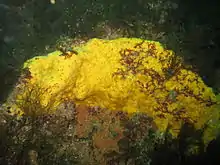Cliona celata
Cliona celata, occasionally called the red boring sponge, is a species of demosponge belonging the family Clionaidae.[1] It is found worldwide. This sponge creates round holes up to 5 millimetres (0.20 in) in diameter in limestone or the shells of molluscs, especially oysters. The sponge itself is often visible as a rather featureless yellow or orange lump at the bottom of the hole.
| Cliona celata | |
|---|---|
 | |
| Scientific classification | |
| Kingdom: | Animalia |
| Phylum: | Porifera |
| Class: | Demospongiae |
| Order: | Clionaida |
| Family: | Clionaidae |
| Genus: | Cliona |
| Species: | C. celata |
| Binomial name | |
| Cliona celata Grant, 1826 | |
| Synonyms | |
|
List
| |
Habitat
These sponges are common in southern New England and in Narragansett Bay. They also live in the Bahamas and the western Atlantic Ocean. They usually live in lagoons or on reefs. They will sometimes make their home on dead mollusks or other shelled creatures.
Reproduction
Red boring sponges can reproduce asexually and sexually. They can simply separate by mitosis, as single cells do, or they can release sperm into the water in hopes of them finding a female's eggs. They may also attach their larvae onto mollusks like clams and mussels. This usually results in the death of the host. They then will begin to grow and colonize. .
